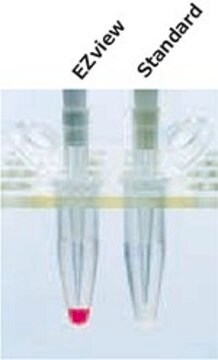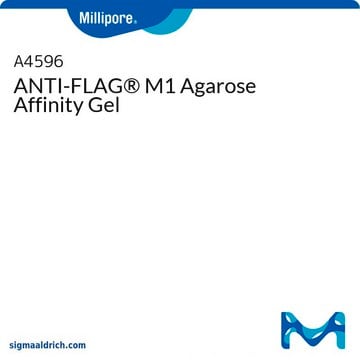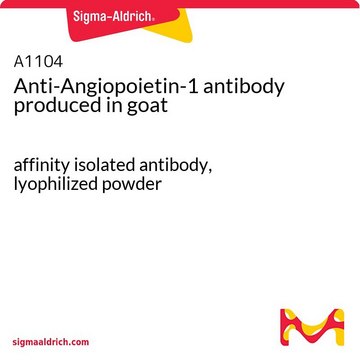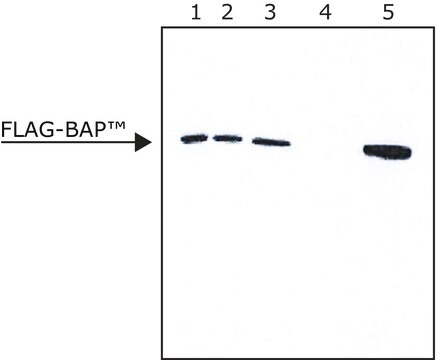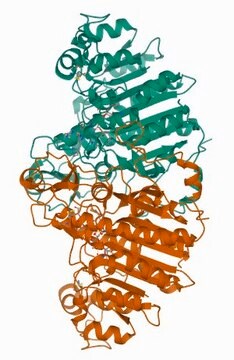A2220
ANTI-FLAG® M2 Affinity Gel
purified immunoglobulin, buffered aqueous glycerol solution
Synonim(y):
Monoclonal ANTI-FLAG® M2 antibody produced in mouse, ANTI-FLAG® M2 Affinity Agarose Gel, Anti-ddddk, Anti-dykddddk
About This Item
Polecane produkty
białko sprzężone
agarose conjugate
forma przeciwciała
purified immunoglobulin
rodzaj przeciwciała
primary antibodies
klon
M2, monoclonal
Formularz
buffered aqueous glycerol solution
klasy chemiczne analitów
proteins
metody
affinity chromatography: suitable
immunoprecipitation (IP): suitable
Matryca
(4% agarose bead; 45-165μm bead size)
izotyp
IgG1
pojemność
>0.6 mg/mL, resin binding capacity (FLAG-BAP)
Warunki transportu
wet ice
temp. przechowywania
−20°C
Szukasz podobnych produktów? Odwiedź Przewodnik dotyczący porównywania produktów
Opis ogólny
Elution - FLAG® peptide, Glycine, pH 3.5, 3x FLAG® peptide
Immunogen
Zastosowanie
Learn more product details in our FLAG® application portal.
Postać fizyczna
Informacje prawne
Oświadczenie o zrzeczeniu się odpowiedzialności
Nie możesz znaleźć właściwego produktu?
Wypróbuj nasz Narzędzie selektora produktów.
najczęściej kupowane z tym produktem
produkt powiązany
Kod klasy składowania
10 - Combustible liquids
Klasa zagrożenia wodnego (WGK)
WGK 1
Temperatura zapłonu (°F)
Not applicable
Temperatura zapłonu (°C)
Not applicable
Wybierz jedną z najnowszych wersji:
Certyfikaty analizy (CoA)
Nie widzisz odpowiedniej wersji?
Jeśli potrzebujesz konkretnej wersji, możesz wyszukać konkretny certyfikat według numeru partii lub serii.
Masz już ten produkt?
Dokumenty związane z niedawno zakupionymi produktami zostały zamieszczone w Bibliotece dokumentów.
Klienci oglądali również te produkty
Protokoły
Protokół immunoprecypitacji (IP) białek fuzyjnych FLAG przy użyciu przeciwciała monoklonalnego M2 w 4% agarozowych żelach powinowactwa
Protocol for immunoprecipitation (IP) of FLAG fusion proteins using M2 monoclonal antibody 4% agarose affinity gels
Powiązane treści
Techniki oczyszczania białek, odczynniki i protokoły oczyszczania rekombinowanych białek przy użyciu metod obejmujących wymianę jonową, wykluczenie wielkości i chromatografię powinowactwa białek.
Techniki oczyszczania białek, odczynniki i protokoły oczyszczania rekombinowanych białek przy użyciu metod obejmujących wymianę jonową, wykluczenie wielkości i chromatografię powinowactwa białek.
Protein purification techniques, reagents, and protocols for purifying recombinant proteins using methods including, ion-exchange, size-exclusion, and protein affinity chromatography.
Nasz zespół naukowców ma doświadczenie we wszystkich obszarach badań, w tym w naukach przyrodniczych, materiałoznawstwie, syntezie chemicznej, chromatografii, analityce i wielu innych dziedzinach.
Skontaktuj się z zespołem ds. pomocy technicznej


